Subtotal
$0
U.S. Shipping
FREE
Saved for Later
Shopping Cart
Subtotal
$0
U.S. Shipping
FREE
Saved for Later
Artists and adventurers have enjoyed the Blue Ridge Mountains for hundreds of years. These mountains may have been depicted in as-yet-undiscovered or time-faded artworks, for these mountains are older than the dinosaurs. In fact, they are the oldest mountains in the United States and the second oldest in the world.
This ancient range has not escaped the attention of impressionist painter Erin Hanson, who paints landscapes all across this great nation. Nor has it escaped the attention of other painters before her, from landscape painter William Louis Sonntag to abstract artist Steven Page Prewitt. Many Native American artists have also used materials foraged from these mountains in their artwork or depicted the range itself in their own works.
There is something magnificent and mysterious about the ancient Blue Ridge Mountains. Something that pulls at the soul of any artist who gazes upon them.
In this article, we will share more about what so many artists see in the United States's oldest mountains.
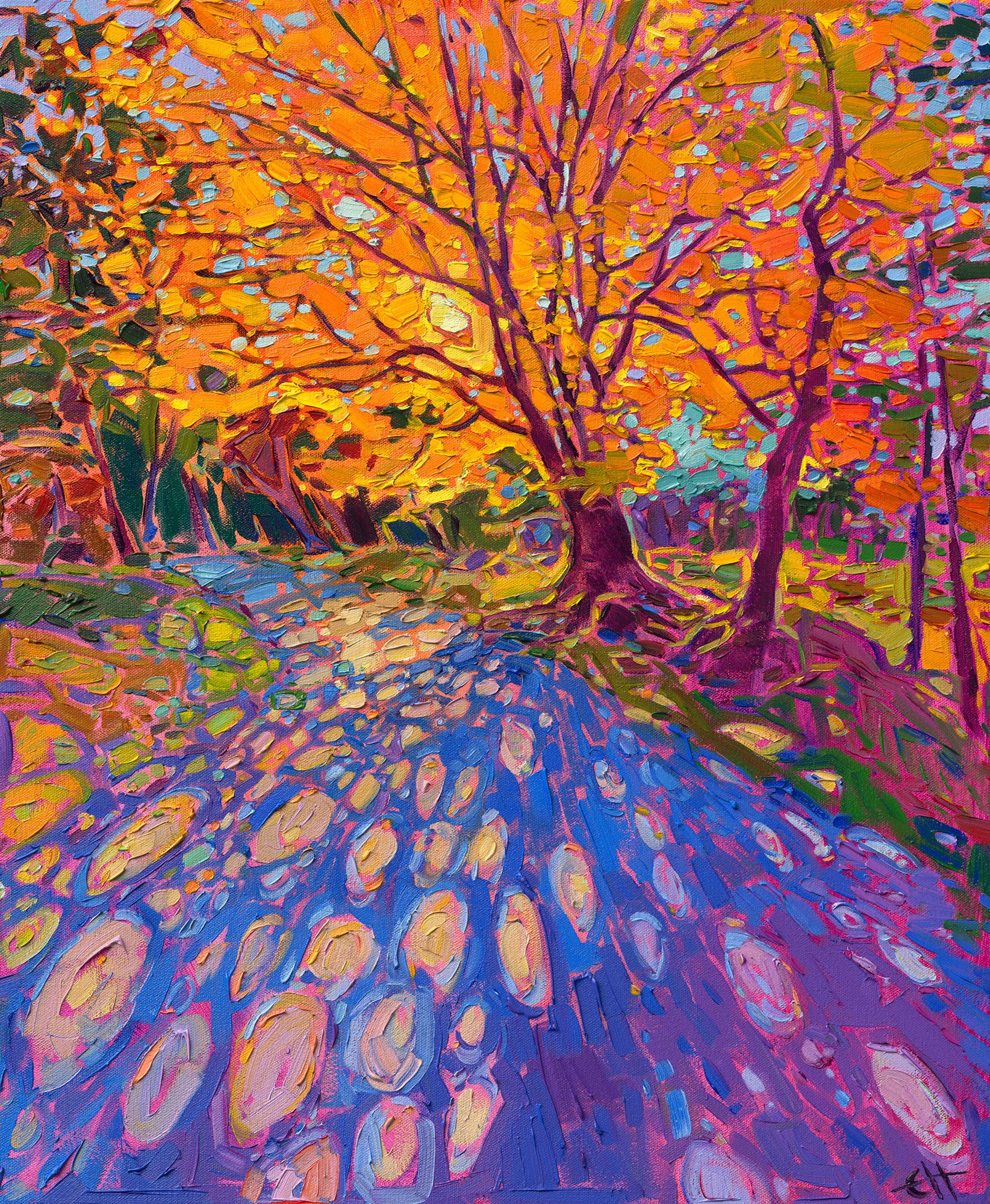
Autumn Lights by Erin Hanson, 2022
We cannot go all the way back to the beginning when the Blue Ridge Mountains formed out of the earth's tectonic plates over one billion years ago. At that time, the Appalachian range did not exist, and the Blue Ridge Mountains towered over everything. When they formed, they were the tallest mountains in the world. But no human eye has ever seen them in their original glory.
Millennia after millennia of wear and tear has worn the mountains down to their existing height, but not before the Appalachian range was formed, the dinosaurs roamed the earth, and ice age glaciers formed and then melted. The sheer amount of history, upheaval, and change these mountains have seen is beyond human comprehension.
Around 11,000 years ago, humans came to this range, finding abundant food for their animals, rich soil for crops, and plentiful food for hunting and gathering. The Cherokee of North Carolina and the Monacan, Saponi, and Tutelo of western Virginia inhabited the Blue Ridge at this time. These cultures still tell stories of their habitation and have left abundant evidence, including artifacts and manmade changes to the landscape. Additionally, many mountain and river names in the region reflect Native American influence.
The mountains cross multiple state lines, and their temperate climate and rolling landscape made the area appealing to early European settlers. Centuries of lore surround the region, and prominent early Americans like George Washington and Thomas Jefferson admired the area.
One question that often arises is, "Why are they called the 'Blue Ridge' mountains?"
When one views the mountain, the forest of spruces and fir trees that dominate the ridge gives off a blue hue. This stunning visual display is helped by the hydrocarbons these trees release, adding a layer of haze over the ridge. These forests once expanded farther down the mountains but have slowly retreated to the cooler heights offered by the range.
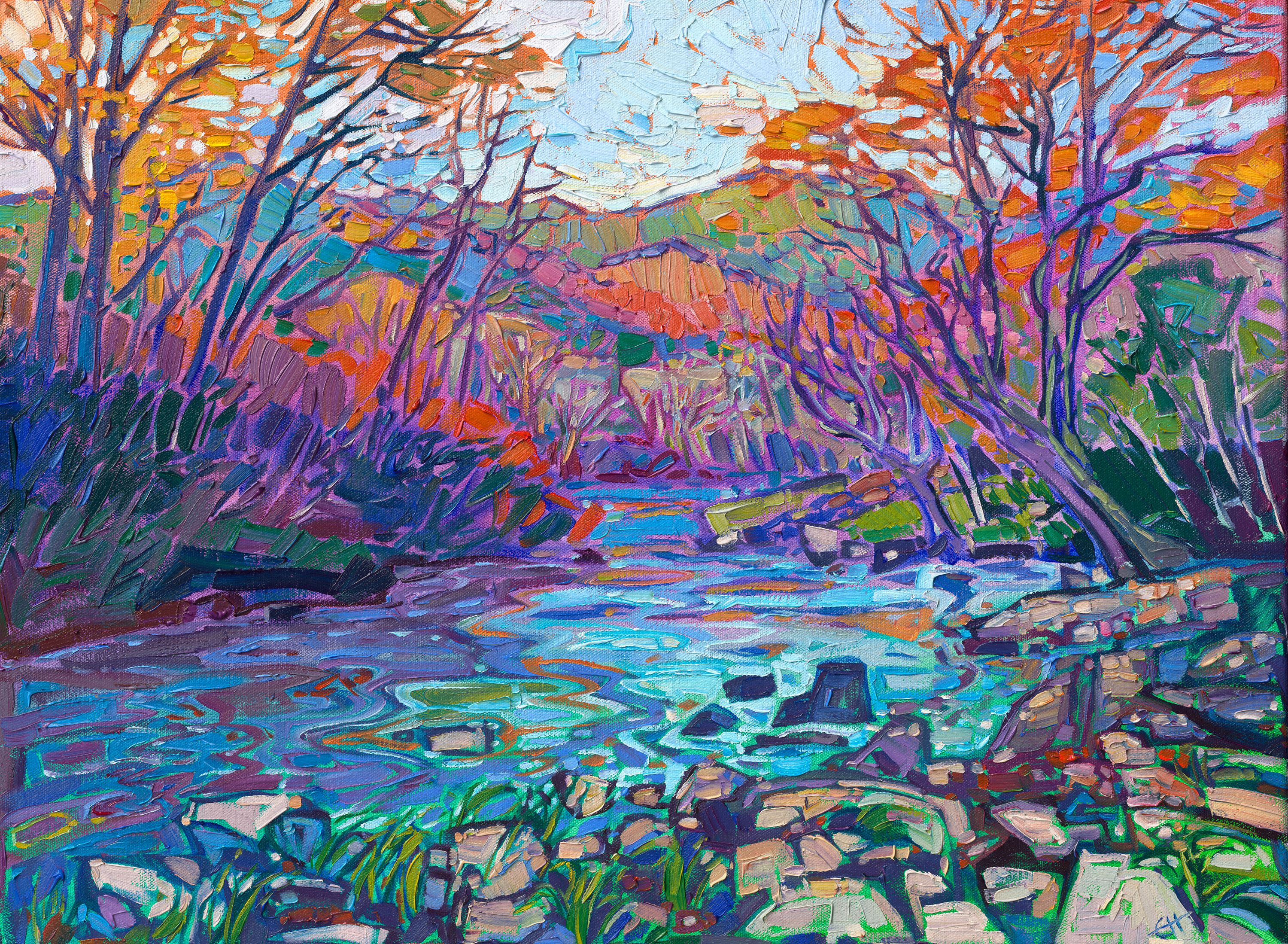
Blue Ridge Waters by Erin Hanson, 2023
The Blue Ridge Mountains have enjoyed visitors from all cultures and backgrounds for centuries. One of the most popular places to visit both in the Blue Ridge Mountains and in the United States is the Blue Ridge Parkway.
469 miles of parkway provide stunning views around the Blue Ridge Mountain Range. This area is incredibly popular, particularly in the autumn. Leaf peepers from all around the U.S. enjoy driving along the highway, stopping at lookouts, taking photos, painting, and becoming inspired by the immense beauty and vibrant color that bathes the mountains during the fall months.
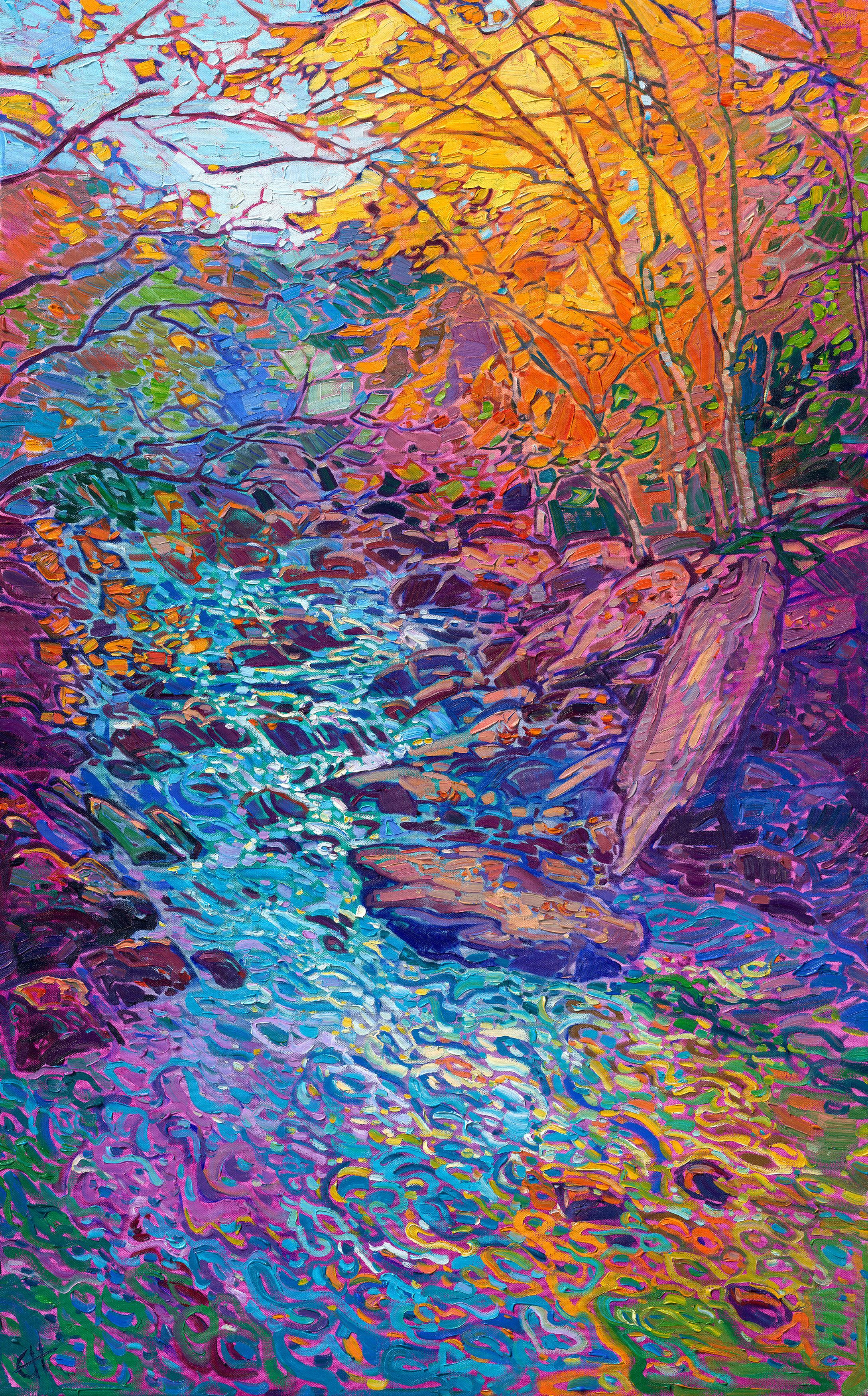
Lighted Brook by Erin Hanson, 2023
Mount Mitchell’s summit is the highest East of the Mississippi. Fortunately, it is also a relatively easy summit to reach. Once you have achieved the summit from one of the four hiking trails on offer, you can enjoy the incredible view from the observation deck.
Here are three primary methods of accessing the summit of Mount Mitchell:
Follow in Erin Hanson’s footsteps and travel down the Blue Ridge Parkway to milepost 297, where Julian Price Memorial Park is located. From here you canoe across Price Lake, picnic at a local picnic site, camp under the stars, hike, or enjoy one of the many seasonal programs put on by locals.
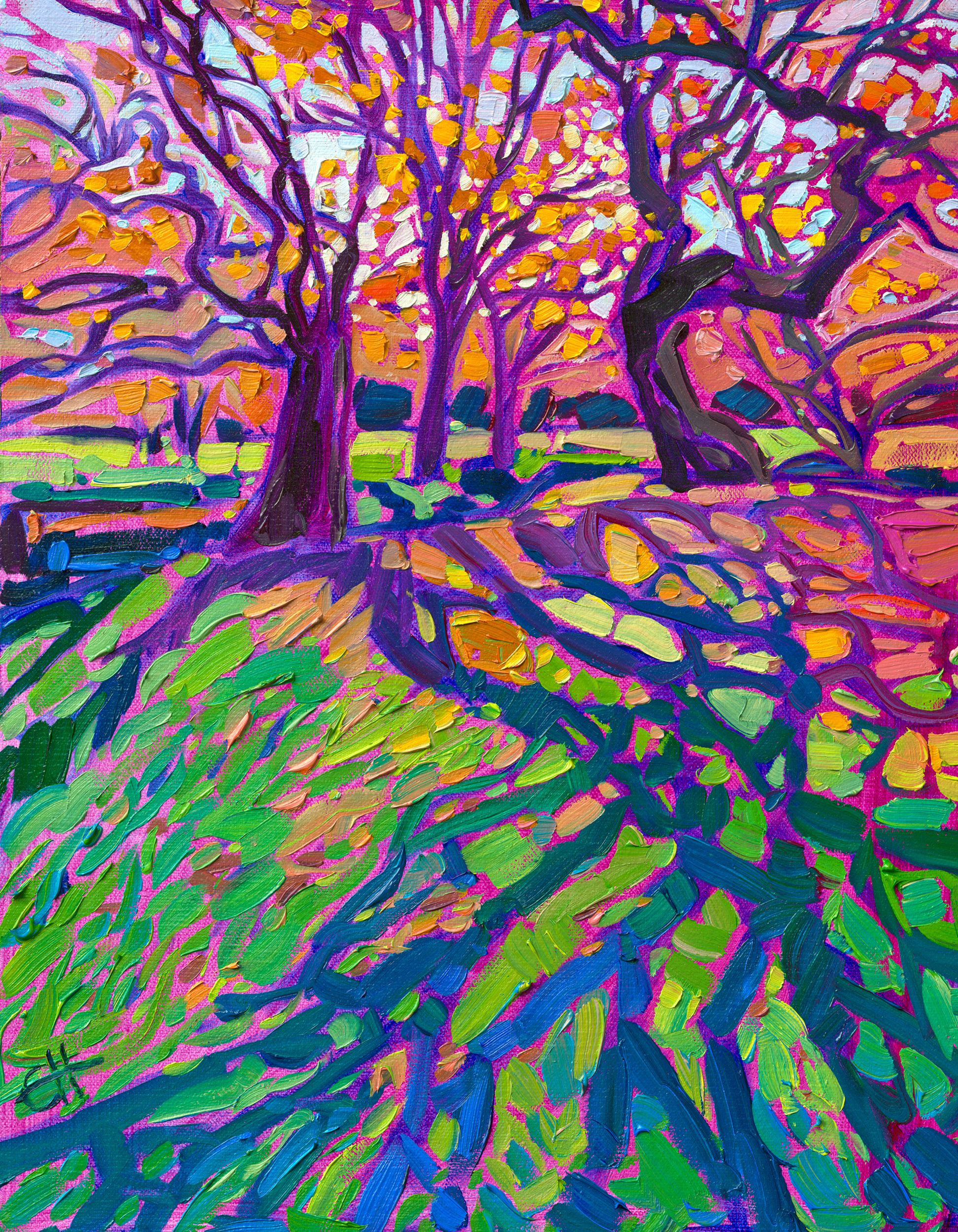
Crystalline Shadow by Erin Hanson, 2023
Grandfather Mountain has grand views, a swinging bridge, seasonal skiing, and much more. This mountain towers 5,946 above northwest North Carolina, and is filled with incredible views, including a very fun, 228-foot suspension bridge called the “Mile High Swinging Bridge.” Fortunately, the original bridge that swung precariously over one mile of empty space has been replaced with steel reinforced with cables and springs. So, the existing bridge does not swing very much. However, now that it has been reinforced, some call it the “singing bridge” as the wind plays the cables like a harmonica, creating lovely music for all to hear.
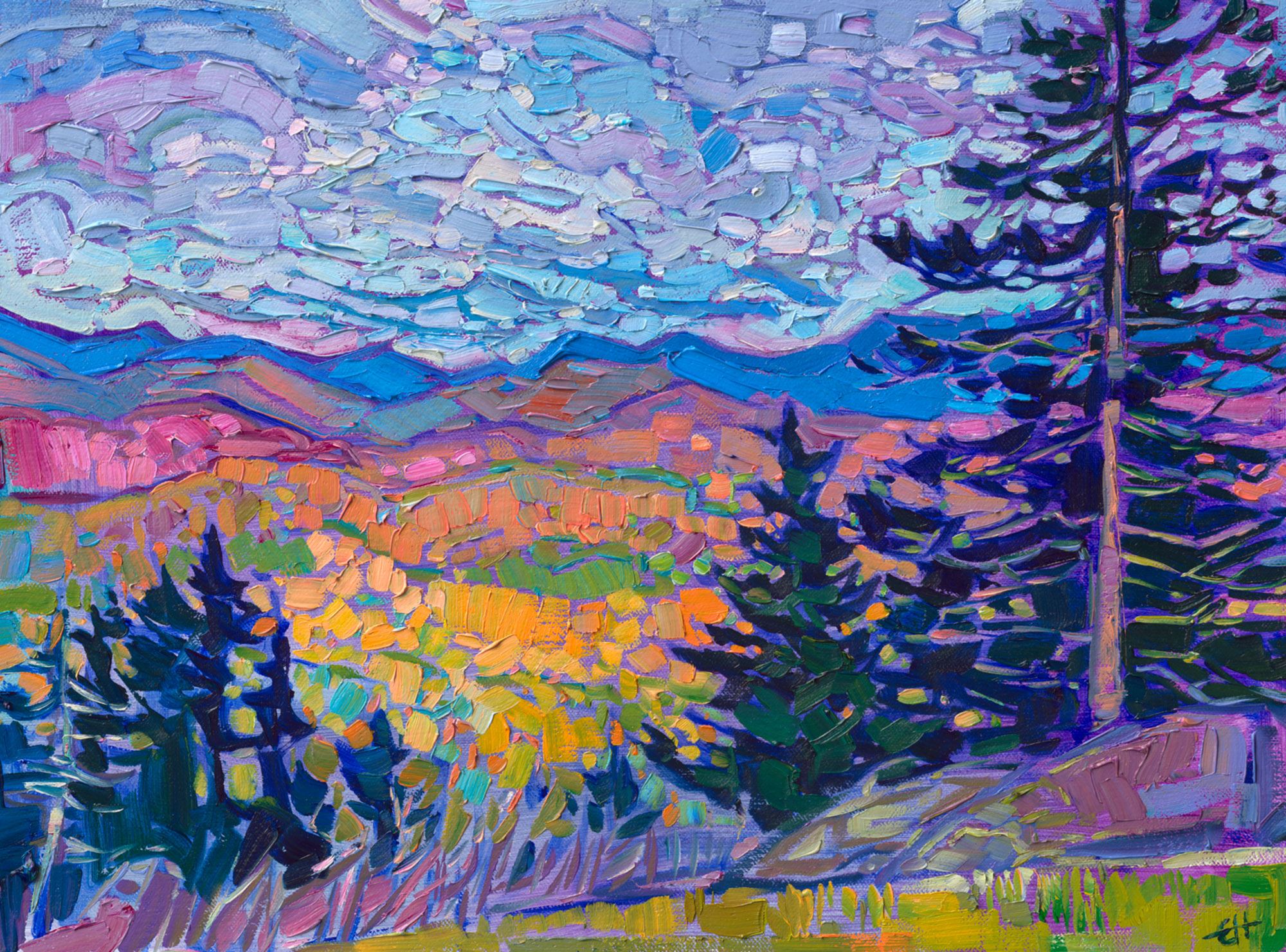
Blue Ridge Pines by Erin Hanson, 2022
Heintooga Round Bottom Road winds down mountainsides for about 14 miles of gravel. While not for the faint of heart, this backroad curves past scenic views, wildflower meadows, waterfalls, and much of the less-seen portions of the Blue Ridge Mountains.
While travel guides say that 4WD is only recommended, this road really does require a 4x4. It is all gravel with some very rough areas. Adventurous souls who enjoy off-roading will love this back road.
Because the mountains are so ancient, art depicting the range has likely existed since humankind first settled the area 11,000 years ago. However, physical works from that ancient date have yet to be discovered.
Ancient art has lived on in native traditions such as basket weaving, woodworking, and storytelling. Many tales furnish a mythological perspective into the lives of those living on this range, and native woven art and carvings reflect these beautiful stories.
European settlers have also created art around this ancient range. Much of the art involves music, folk tales, and carvings that depict surrounding landscapes and animals. You might be familiar with one of the more famous references to the Blue Ridge Mountains, made by John Denver in Take Me Home, Country Roads.
In the 1800s, oil painter William Louis Sonntag put brush to board and created a lovely painting called The Blue Ridge Mountains. Since then, many artists have depicted the Blue Ridge Mountains in paint, and those artists include Erin Hanson.
Here are a few of her landscapes in oil that showcase the beauty of the Blue Ridge mountains.
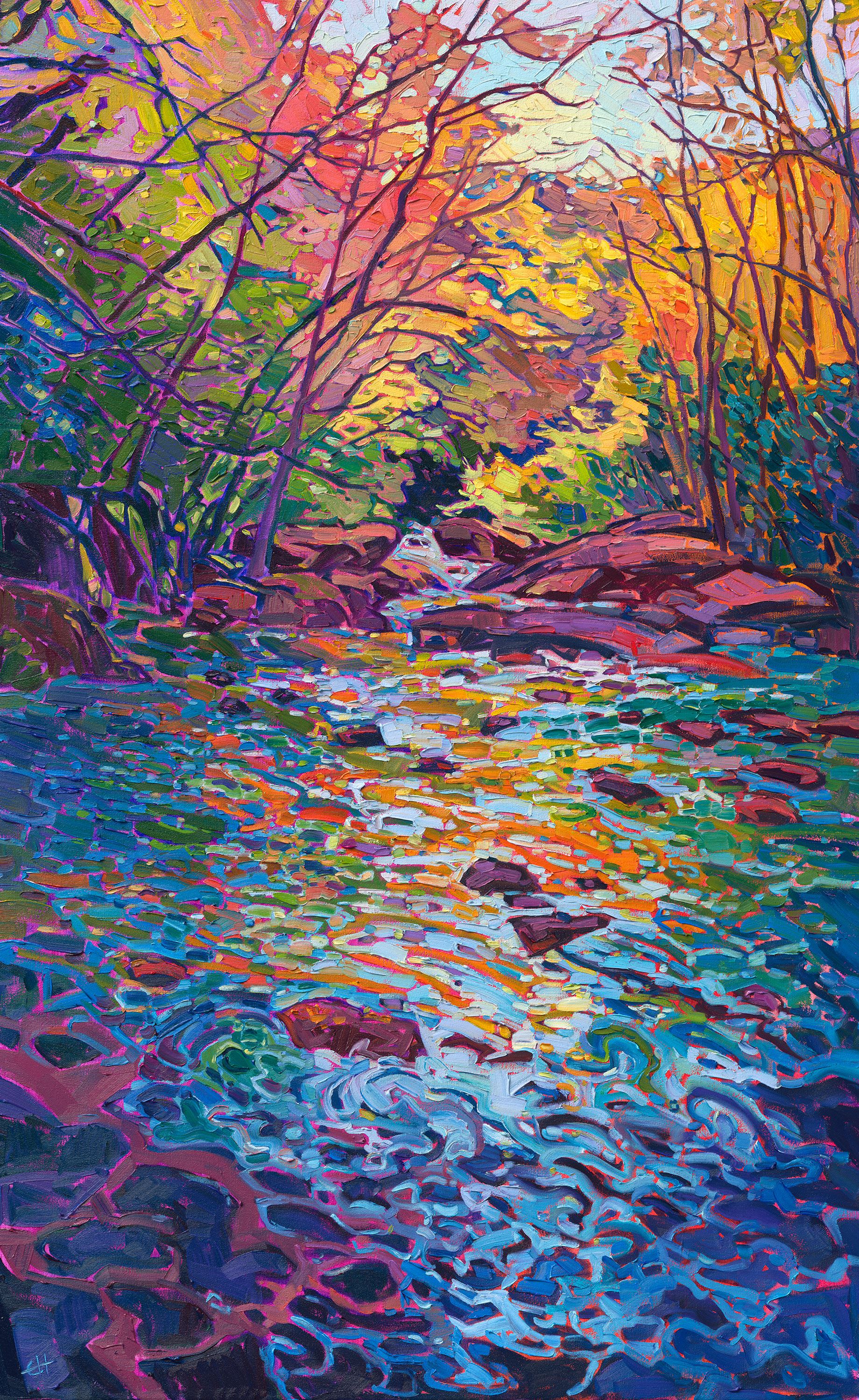
Running Reflections by Erin Hanson, 2022
A rippling creek of icy mountain water flows over moss-covered rocks in this painting of Lance Creek, near Boone in the Blue Ridge Mountains. Sunlit hues of autumn surround the creek, casting delicate reflections of brilliant color across the swirling waters.
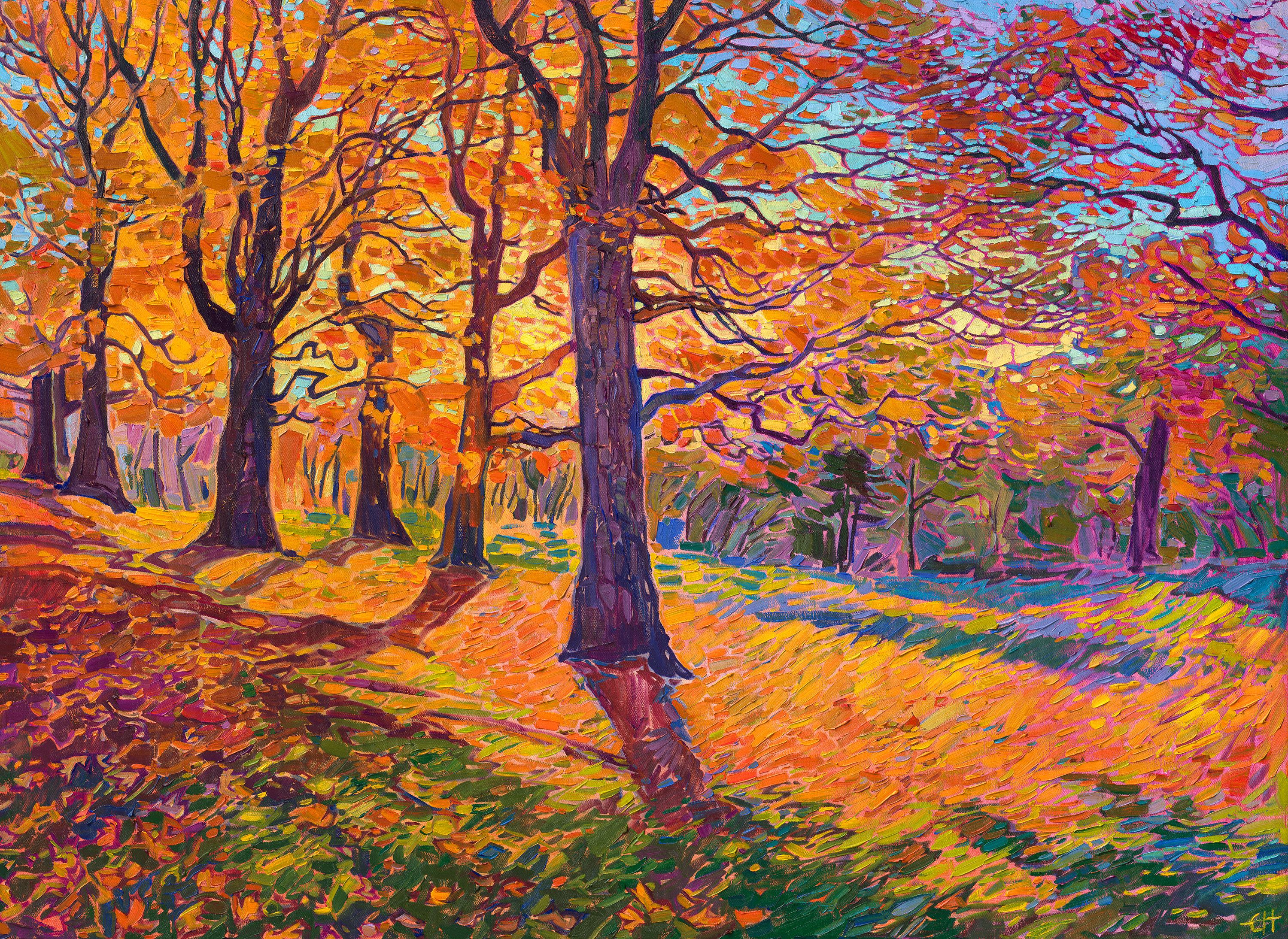
Appalachian Oaks by Erin Hanson, 2022
Rich hues of orange and gold blanket the landscape with fall color in this painting of the Blue Ridge Mountains in South Carolina. This painting was inspired by a hike through the Cone Manor property. The late afternoon shadows cast dramatic, abstract shapes across the leaf-covered grass.
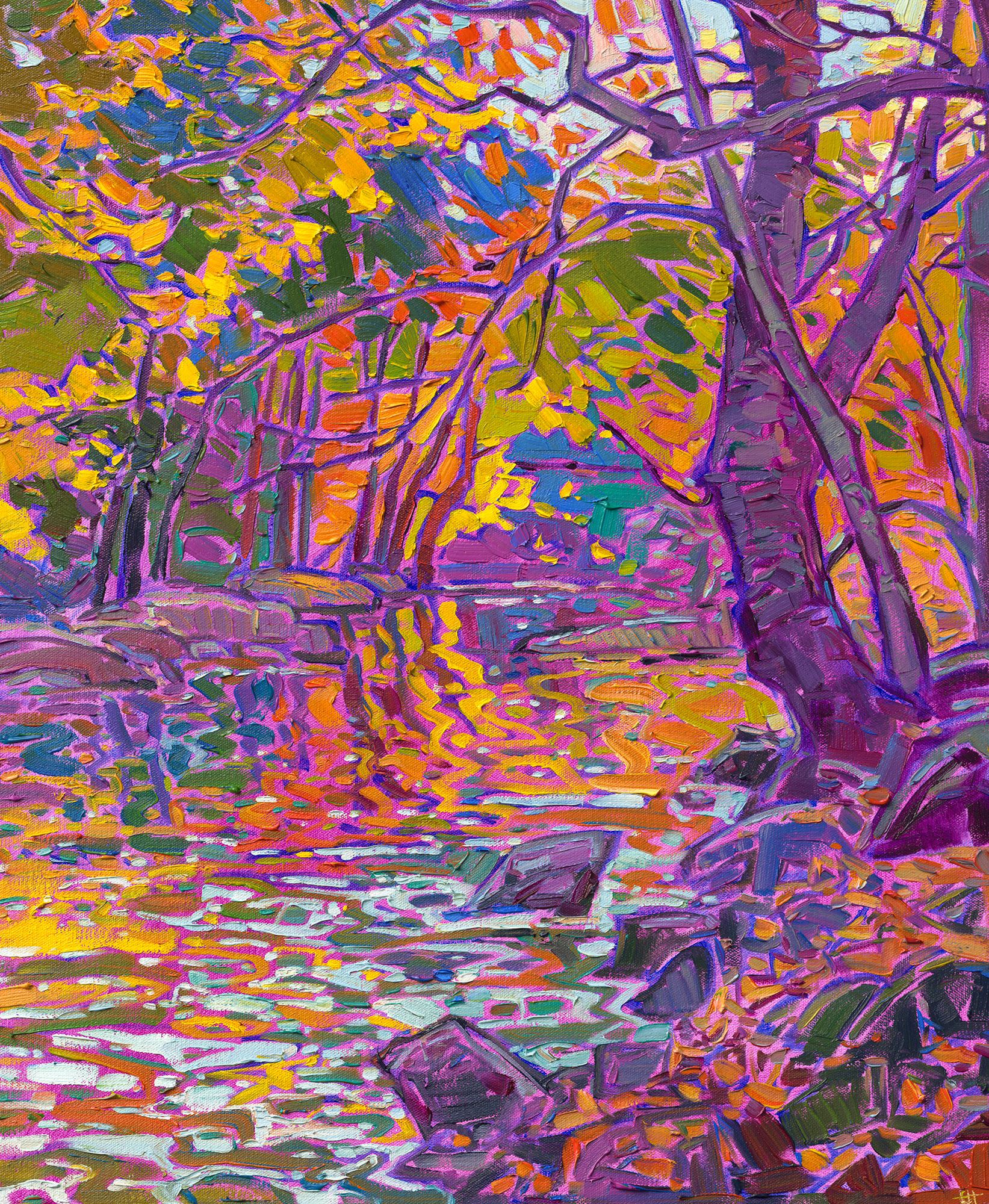
Maple River by Erin Hanson, 2022
Loose, expressive brush strokes capture the vivid hues of east coast autumn color. The painting depicts a secluded vista of a quiet brook reflecting the yellow, red, and gold fall colors all around.
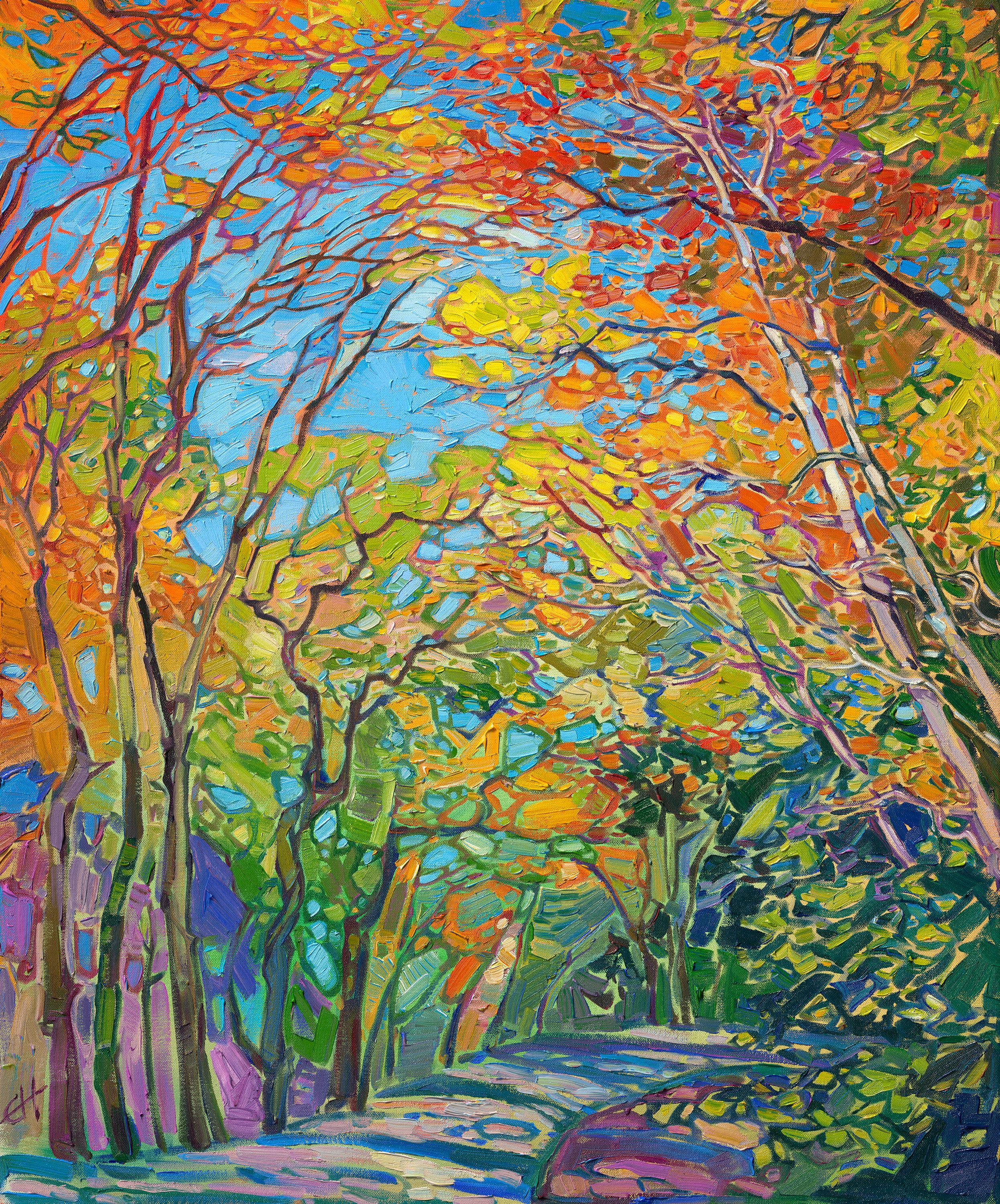
Autumn in Light by Erin Hanson, 2023
Delicate autumn light illuminates this tree-lined path, making the stately trees of the Blue Ridge Mountains glow with fall colors. This painting captures the striking beauty of autumn with thick, expressive brush strokes of oil paint that have the feeling of stained glass.

Reflections of Autumn by Erin Hanson, 2023
Rainbow reflections of autumn hues sparkle in the stream of water. I discovered this little creek hiking into the woods in the Blue Ridge Mountains. The brush strokes are thickly applied in loose, expressive strokes, capturing the movement and vitality of the scene.
These artworks share a vision of the Blue Ridge Mountains in fall, when Appalachia is most colorful. Find more landscape art showcasing the Blue Ridge Mountains and Appalachia here. Explore all of Erin Hanson's vibrant landscape art in her signature open impressionist style by clicking here.
Sources:
https://friendsofblueridge.org
https://www.nps.gov/blri/learn/historyculture/native-american-culture-and-influence.htm
https://www.virtualblueridge.com/parkway-info/culture/#google_vignette
https://blog.allentate.com/blue-ridge-geology
https://www.blueridgeparkway.org/poi/julian-price-memorial-park/
https://www.ncparks.gov/state-parks/mount-mitchell-state-park
https://blueridgemountainlife.com/
Discover the artist at the forefront of modern impressionism.

About Erin
ERIN HANSON has been painting in oils since she was 8 years old. As a teenager, she apprenticed at a mural studio where she worked on 40-foot-long paintings while selling art commissions on the side. After being told it was too hard to make a living as an artist, she got her degree in Bioengineering from UC Berkeley. Afterward, Erin became a rock climber at Red Rock Canyon, Nevada. Inspired by the colorful scenery she was climbing, she decided to return to her love of painting and create one new painting every week.
She has stuck to that decision, becoming one of the most prolific artists in history, with over 3,000 oil paintings sold to eager collectors. Erin Hanson’s style is known as "Open Impressionism" and is taught in art schools worldwide. With millions of followers, Hanson has become an iconic, driving force in the rebirth of impressionism, inspiring thousands of other artists to pick up the brush.